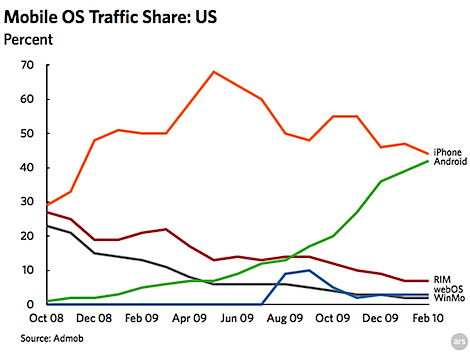About that ‘Unbiased’ AdMob Android Graph We Keep Seeing…
James wrote something yesterday that included this graphic:
What caught my attention, as was the intention of the graphic, was the Android traffic number climbing from effectively zero to more than 40% in just a year and a couple of months. Obviously this was the intention of the graphic (note the green color of the line… designers use green to symbolize wealth) but given that it is published by Admob, which is being acquired by Google, I think you would have to take this chart with a healthy dose of skeptically driven “show me” before you accept it as fact.
The reason I suggest we have some skepticism about this is not because the data is fabricated but because it suggests something very specific that is different from showing Android is beating Blackberry, Windows Mobile, and Palm (although it is believable on the latter) in one statistic that matters, device sales, but rather that application usage on Android is achieving parity with Apple.
I downloaded the Admob Mobile Metrics Report and it is very clear, this chart is derived from an analysis of Admob’s network traffic, not mobile network traffic by device or by carrier. Admob, which serves ads into 15k websites and apps on iPhone and Android, analyzes their traffic and trends it according to the type of OS and type of handset (smartphone or feature phone), but also internet devices like the iPod Touch and the upcoming iPad.
Admob claims 10 billion monthly impressions, which no doubt provides a snapshot of trend data but one subject to a lot of interpretation as it does not include meaningful traffic from Windows Mobile or Blackberry devices as those markets have demonstrated less tendency to browse websites with their devices. Let’s set aside for a moment the strategic implications of this observation by agreeing that Windows Mobile and Blackberry have squandered a big headstart in this market which enabled Apple to brilliantly exploit web browsing as a core competency of the iPhone… and later apps (although as I have pointed out before, Apple was originally hostile to external developers building apps for the iPhone).
Traffic, or Device Sales: Which Matters Most?
This leads me to the main point of this post, which is to ask the question what matters more, how many devices are sold or how consumers use them? There is no denying that the device sales underpin everything for handset manufacturers because that is what carriers respond to and where the handset manufacturers generate revenue, but there is no denying that despite impressive sales numbers by RIM and Microsoft (which isn’t a handset manufacturer but should be considered one for the purpose of this analysis) but at the same time each of these platforms has become less important in the consumer space as the iPhone and Android have dominated the consumer mindset.
![]() I don’t have hard numbers to back this up but I think anecdotal observation is undeniable, consumers use the iPhones and Android devices in a fundamentally different way than their Blackberries and other smartphones. I do recall a statistic that I read recently which said the average iPhone user has 11 installed applications versus 3.5 for the average Blackberry user, and I suspect the divide is equally stark against Windows Mobile devices, and it’s clear that Android was developed to mimic the iPhone in this regard.
I don’t have hard numbers to back this up but I think anecdotal observation is undeniable, consumers use the iPhones and Android devices in a fundamentally different way than their Blackberries and other smartphones. I do recall a statistic that I read recently which said the average iPhone user has 11 installed applications versus 3.5 for the average Blackberry user, and I suspect the divide is equally stark against Windows Mobile devices, and it’s clear that Android was developed to mimic the iPhone in this regard.
If we accept that the iPhone/Android markets are doing more than just reading their email and making calls, does this reflect better capabilities of the devices or a far more simple process for acquiring and installing apps on the iPhone/Android? The answer is clearly yes because the app marketplaces and extensive third party developer capabilities, as well as the unique aspects of the handsets, have resulted in a massively more extensive and vibrant market for mobile applications than on the Blackberry and Windows Mobile counterparts. No denying this.
Now here is where things get interesting. Carriers price their wireless plans with voice and data components, with data predominately offered as all you can eat pricing so with data consumption growing at over 100% annually the carriers are seeing growth in the one part of their network they can’t monetize while at the same time incurring significant capital expenditures for network build out. That data traffic has been surging creates a range of problems for carriers who by all accounts cannot expand their networks fast enough (or afford to when they can’t charge subscribers $60 or $70 a month for data), including degrading voice capability (which is profitable) to add to data network bandwidth.
The other problem that data presents is that it erodes a business that is super profitable for carriers, SMS which generates about 20% or $200 billion of global telco revenues. As apps increasingly provide notification capability and instant messaging, carriers will be put in a real quandary and I suspect we will see them throttle apps that infringe on their core businesses (like voice and SMS), as well as apps that are bandwidth hogs (like Slingbox for mobile).
There is a fellow by the name of Andrew Odlyzko that you should take the time to read up on if you are interested in these topics. Andrew is a Professor in the School of Mathematics at the University of Minnesota and by all accounts one of the most accomplished researchers who specializes in the economics of network consumption. Odlyzko believes that voice is seriously underrated as a market and carriers are making a strategic error by not improving the quality of voice and seamlessly integrating voice with data, but he also asserts that data traffic rates will fall from their aggressive growth rates to somewhere around 30%.
Where this brings us is full circle, if mobile network traffic does trend down then the lines on the network traffic graph provided by Admob would converge, or put another way, normalize. It’s not to suggest that Admob is wrong, only that you have to look at their data with a complex set of filters that put into perspective the limited solar system they are measuring. The other implication of all this is that all you can eat data is likely a phenomena that consumers will not enjoy in perpetuity, or access to mobile apps will be filtered according to the bandwidth they consume. I think it is also plausible to consider that mobile data pricing plans will be tiered according to the device the consumer is using, as in Blackberry users typically use less data therefore have a cheaper data plan than iPhone users.
Whatever the eventuality, one this is clear and that is the wireless market is getting much more complex.
A message from John Furrier, co-founder of SiliconANGLE:
Your vote of support is important to us and it helps us keep the content FREE.
One click below supports our mission to provide free, deep, and relevant content.
Join our community on YouTube
Join the community that includes more than 15,000 #CubeAlumni experts, including Amazon.com CEO Andy Jassy, Dell Technologies founder and CEO Michael Dell, Intel CEO Pat Gelsinger, and many more luminaries and experts.
THANK YOU














